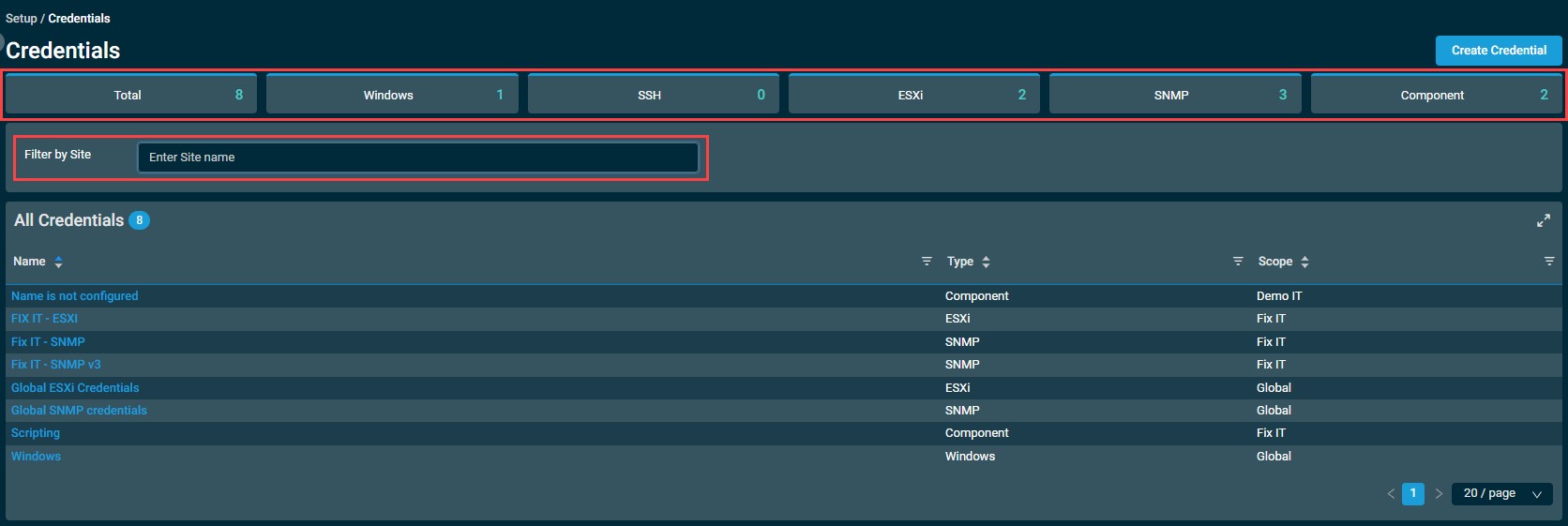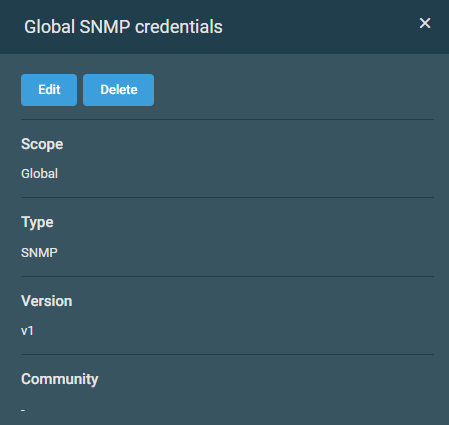Credentials
PERMISSIONS Refer to Sites > Settings and Setup > Global Settings in Permissions.
NAVIGATION Setup > Credentials
About
You can manage various types of credentials on the Credentials page. This single page allows you to manage both global and site-level credentials, including view, create, edit, and delete functionality.
You can create and manage the following types of credentials:
Creating a credential
On the Credentials page, click Create Credential and specify the details of the credential.
Enter a name for the credential.
NOTE The Name field has a limit of 255 characters.
NOTE If the name entered begins or ends with any spaces, those spaces will be automatically deleted upon saving the credential. This allows for accurate alphabetical sorting of the Name column in the List of credentials.
Choose one of the following options:
- Global: The credential will apply to all sites in the Datto RMM account.
- Site: The credential will only apply to one site. Once this option is selected, enter a site name. The search results will be narrowed as you type.
NOTE The Component credential option is only available for the Site scope.
NOTE For global ESXi and SNMP credentials to be displayed in addition to site-level ESXi and SNMP credentials in the New UI, the use of global (account-level) credentials must be set to ON in Site Settings in the legacy UI. Refer to ESXi Credentials and SNMP Credentials in Site Settings - Legacy UI.
Select the type of credential you would like to create and configure its details.
To be able to deploy an Agent across a LAN, you will need to have a username and a password for the devices you want to install the Agent on. You can save these credentials so that you don't have to enter them when adding new devices. At the time of initiating Agent deployment, you will be prompted to select a set of credentials. Refer to LAN deployment from the web interface.
- In the Username field, enter a username.
- In the Password field, enter a password. The password will be hidden as you type.
If you would like to manage ESXi devices in Datto RMM, you can save their credentials so that you don't have to enter them when adding new devices. Cached ESXi credentials are also used during network discovery. For information about how to add ESXi devices, refer to Managing and monitoring ESXi devices.
Configure the following details:
| Field | Description |
|---|---|
| vSphere Username | Enter a vSphere username. |
| vSphere Password | Enter a vSphere password. The password is hidden as you type. |
| CIM Port | Enter the CIM port number. By default, it is set to 5989. The maximum value is 65,534. |
| Port | Enter a port number. By default, it is set to 443. The maximum value is 65,534. |
If you would like to manage SNMP-enabled devices in Datto RMM, you can save their credentials so that you don't have to enter them when adding new devices. Cached SNMP credentials are also used during Network Discovery. For more information, refer to Managing and monitoring SNMP-enabled network devices and printers.
-
Select one of the following versions: v1, v2c, or v3.
NOTE SNMP v1 and v2c only need a name and a community string; however, SNMP v3 requires more complex security. If you are not sure which settings to configure in Datto RMM to be able to connect to your network device over SNMP, refer to the SNMP device's documentation or provider for more details.
-
If you have selected v1 or v2c and your device has a customized community string, enter it into the Community field. The community string works as a password. If the field is left blank, the default read-only community string public is applied.
If you have selected v3, configure the following details:
| Field | Description |
|---|---|
| v3 User | Enter a v3 username. |
| Authentication | Select an authentication protocol: • None • MD5 • SHA1 |
| v3 Password | Enter a v3 password at least 8 characters long. The password is hidden as you type. If you have selected None in the Authentication section, this field becomes inactive. |
| Encryption | Select an encryption standard: • AES128 • DES • None |
| v3 Encryption Key | Enter a v3 encryption key. If you have selected None in the Encryption section, this field becomes inactive. |
| Context | If you know the SNMP context ID defined on the target device, enter the value here to be able to access the correct device information. NOTE An SNMP context is a collection of management information, identified by a Context ID and a Context Name (source: The Internet Engineering Task Force). |
To be able to deploy an Agent across a LAN, you will need to have a username and a password for the devices you want to install the Agent on. You can save these credentials so that you don't have to enter them when adding new devices. At the time of initiating Agent deployment, you will be prompted to select a set of credentials. Refer to LAN deployment from the web interface.
- In the Username field, enter a username.
- In the Password field, enter a password. The password will be hidden as you type.
NOTE The Component credential option is only available for the Site scope.
You can save credentials to be used by components. Caching credentials for components is useful if you want to run a single component against multiple sites, and each site needs a different credential. If the component you want to run is configured to require credentials, the credentials saved for the individual sites will be used at run time. Each site can only have one component credential.
To save a component credential for a site, follow these steps:
- Select a site in the Scope section and select Component in the Type section.
- In the Username field, enter a username.
- In the Password field, enter a password. The password will be hidden as you type.
If a component credential already exists for a site, you will see a warning message. You can click the Edit existing component credentials button to change the credential if needed.
To learn how to configure a component to require credentials, refer to Script in Creating a component.
Click Create Credential to save the credential or click Cancel to discard the changes.
NOTE You will only be able to save the credential if you have entered a name for it.
Viewing and managing credentials
To see all global and site-level credentials configured in your Datto RMM account, navigate to the Credentials page. To see only one type of credentials, select a type at the top of the page. To see a list of credentials of only one site, enter a site name in the Filter by Site field above the All Credentials table. The search results will be narrowed as you type.
The table displays the following information:
| Field | Sortable? | Description |
|---|---|---|
| Name |
|
The name of the credential. To edit the credential, click its name. Refer to Editing or deleting a credential. To narrow the list, click the filter icon NOTE Component credentials created in Site Settings > Credentials in the legacy UI do not have names and display Name is not configured under the Name column in the New UI. Click Name is not configured to edit the component credential and update its name. |
| Type |
|
Displays the type of the credential. Refer to Type. To narrow the list, click the filter icon |
| Scope |
|
This field indicates whether the credential applies to all sites or only one site in the Datto RMM account. Refer to Scope. Click the filter icon |
The table density is set to condensed theme by default. To change it to relaxed theme, click the density toggle icon. ![]() The selection will persist across all pages.
The selection will persist across all pages.
The number of results displayed can be specified by selecting the desired number from the pagination control. This selection will persist the next time the page is accessed.
Click the name of the credential to open its detail pane. You can edit the credential in the following ways:
- To update the details of the credential, click Edit. Refer to Creating a credential.
NOTE The Scope and Type of the credential are not editable.
- To delete the credential, click Delete. Note that if devices are using the credential you are about to delete, they will be affected.
In the confirmation dialog box that appears, select the I understand that this action is irreversible check box to confirm the action. Click Delete to execute the action or Cancel to close out of the dialog box.




